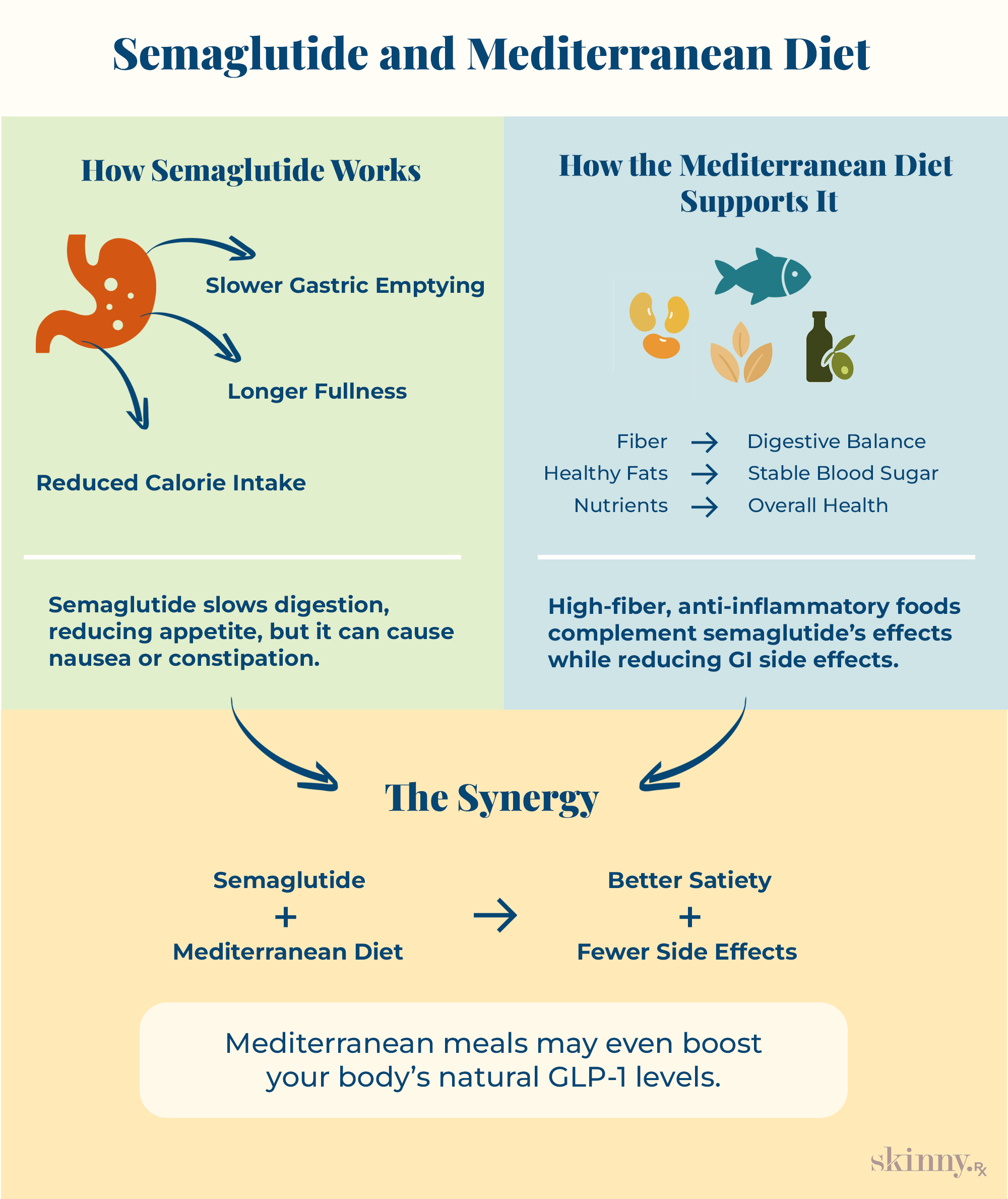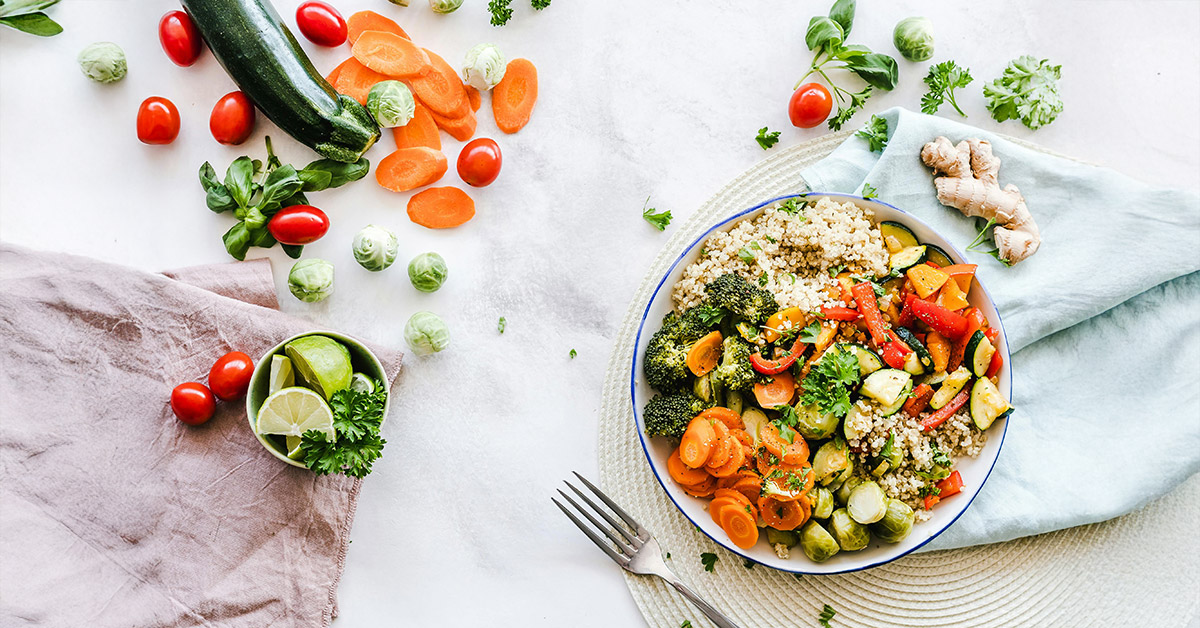
Key Takeaways
- Pairing semaglutide with the Mediterranean diet strengthens appetite control, stabilizes blood sugar, and promotes more consistent weight loss results.
- The diet’s fiber, healthy fats, and lean proteins help offset the side effects of semaglutide, such as nausea, bloating, and constipation.
- Together, they support smoother digestion, steadier energy, and greater comfort as your body adjusts to GLP-1 treatment.
- A Mediterranean-style approach also supports long-term heart and metabolic health, making your weight loss more sustainable.
- Emphasizing fiber-rich vegetables, whole grains, and protein-focused meals keeps you satisfied between doses and reduces overeating.
Medications like semaglutide—a GLP-1 agonist marketed as Wegovy® and Ozempic®—can help you lose weight. But what you eat while taking them matters just as much. For your health, ability to maintain your weight, and, specifically, when taking a GLP-1 agonist, managing side effects.
A semaglutide Mediterranean diet approach is one of the best options for people taking GLP-1s. It’s not overly restrictive, so you won’t feel socially isolated or deprived, and its focus on healthy fats, fiber, and whole foods can help ease the GI symptoms associated with GLP-1 use.
It’s also one of the most extensively studied eating patterns for heart health, metabolic health, and longevity.
Why the Mediterranean Diet Works Well With Semaglutide
To understand why the Mediterranean diet pairs well with semaglutide, it helps to know how GLP-1 agonists affect digestion. They slow gastric emptying, meaning food stays in your stomach longer, keeping you fuller between meals and reducing overall calorie intake.
But fullness alone isn’t a guarantee of progress. The quality of one’s diet matters, and if you fill up on empty calories or those with little to no nutritional value, you may undermine your overall health and well-being.
Empty calories also do little to fill you up while contributing to your daily intake, and so you may find that your weight is plateauing or even rising when you eat high amounts of these foods.
Semaglutide and other GLP-1 medications can also cause side effects like bloating, nausea, constipation, and semaglutide burping. They’re uncomfortable and can dissuade people from continuing to use them.
The Mediterranean diet supports both weight loss and symptom management. Modeled after the eating habits of countries such as Greece, Italy, Spain, and France, it centers on fruits, vegetables, legumes, whole grains, olive oil, fish, and modest portions of dairy and lean protein.
These foods are filling yet relatively low in calories, gentle on the digestive system, nutrient-dense, and backed by strong clinical evidence for improving heart and metabolic health. Here’s a more in-depth breakdown of how the Mediterranean diet can pair with semaglutide use.

It Complements Semaglutide's Appetite Suppression
The Mediterranean diet helps control appetite in two ways: with fiber and by triggering a hormonal response. Its high intake of fruits, vegetables, legumes, and whole grains is naturally rich in fiber, which absorbs water and expands in your digestive tract, helping you stay satisfied between meals.
It also appears to stimulate the body’s natural GLP-1 production, the same gut hormone activated by semaglutide. In one study published in Diabetes, Metabolism Research and Reviews, researchers compared the Mediterranean diet with a high-fiber vegetarian plan in people with type 2 diabetes.
They found that the Mediterranean pattern was more effective at stimulating GLP-1 release after meals. Practically, this means eating a Mediterranean diet while on Semaglutide may reinforce the medication's hormonal effects while helping to control blood sugar and hunger cues.
The High Fiber Content Helps With Constipation
Constipation affects between 12 and 35 percent of people taking a GLP-1 agonist. Increasing your fiber intake, which the Mediterranean diet naturally encourages, can provide some relief.
There are two types of fiber: soluble and insoluble. Insoluble fiber isn’t digested by your body, and creates bulk to move stool along and out of your digestive tract. Meanwhile, soluble fiber absorbs water, turning into a gel-like substance that can soften your stools, making them easier to pass.
Aim for 25 to 38 grams of fiber daily from whole foods, including vegetables, fruits, beans, nuts, seeds, legumes, and whole grains.

For folks wanting to optimize their diet and health during their weight loss journey, the Mediterranean Diet is a rock-solid approach.
–
Whitney Linsenmeyer, PhD, RD, Assistant Professor of Nutrition and Dietetics
It’s Beneficial to Your Overall Health
Strip away the branding, and the Mediterranean diet is simply a practical approach to eating well: plenty of fruits and vegetables, high-fiber foods, limited added sugars and alcohol, and lean protein sources.
Even if you know little about nutrition, these are the foods most people intuitively recognize as “healthy.” The difference is that the health benefits of the Mediterranean diet are proven, not just hearsay.
One long-term study followed over 22,000 participants in Greece and ranked their adherence to the Mediterranean diet on a scale of 0 to 10. It was found that individuals with a higher adherence score experienced a significant reduction in all-cause mortality.
Another study found a correlation between higher adherence to the Mediterranean diet and a reduced risk of cancer.
The takeaway is this: adopting this eating pattern while using semaglutide doesn’t just support weight loss (and it does), it promotes whole-body health in the long term.

Expert-Guided, Sustainable Weight Loss
Discover how proven medications such as semaglutide or tirzepatide, combined with expert support, can help you reach lasting weight loss results.
Core Principles of the Mediterranean Diet
There are no strict rules for following the Mediterranean diet, dictating what foods to eat, when to eat them, and in what quantities. Instead, it’s a set of guiding principles that encourage balance, variety, and moderation. The focus is on whole, minimally processed foods, healthy fats, lean proteins, and plenty of plants (with a bit of red wine if you drink).
Here’s how to put those principles into practice.
What Foods to Emphasize
- Healthy fats (olive oil, avocados, nuts)
- Fruits
- Vegetables
- Whole grains
- Legumes (beans, lentils, chickpeas)
- Fish and seafood
- Eggs
- Poultry
- Dairy (yogurt and cheese)
What Foods to Limit or Avoid
- Red meat
- Added sugars
- Refined grains
- Highly processed foods
- Alcohol (though the occasional glass of red wine is ok)
Your Mediterranean Diet Shopping List
Below is an extensive list of foods you can eat on the Mediterranean diet. You don’t have to buy all of these foods, but all the options let you rotate through a near-endless number of recipes.
- Vegetables: Garlic, onions, scallions, spinach, kale, arugula, mixed greens, broccoli, asparagus, zucchini, mushrooms, eggplant, cucumber, tomatoes (fresh + canned/diced), cherry tomatoes, carrots, celery, bell peppers, fennel, potatoes (baby, red, or Yukon gold), squash, beets, romaine lettuce, dill, parsley, capers, artichokes, peas, olives, lemon, and other citrus
- Fruits: Apples, pears, oranges, lemons, limes, strawberries, blueberries, bananas, melon, grapes, figs, dates, raisins, cherries, apricots, avocados, pomegranates
- Healthy fats: Extra virgin olive oil, avocado oil, ghee (optional), grapeseed oil, tahini, nut butters (optional), and olives
- Protein: Chicken thighs or breasts, turkey, salmon, sardines, cod, mackerel, shrimp, scallops, tuna (fresh or canned), eggs
- Grains: Whole-grain bread, pita bread, brown rice, quinoa, farro, bulgur, barley, orzo, chickpea pasta, whole-wheat pasta, oatmeal, whole-grain toast
- Dairy and other staples: Greek yogurt, ricotta cheese, mozzarella, feta cheese, milk or milk alternative (if needed), tzatziki, baba ganoush, tahini-yogurt sauce, honey
- Beans and legumes: Chickpeas, lentils, black beans, kidney beans, pinto beans, cannellini beans, hummus
- Nuts and seeds: Almonds, walnuts, pine nuts, cashews, peanuts, chia seeds, sesame seeds
- Pantry items and seasonings: Salt, pepper, olive oil, oregano, basil, rosemary, thyme, cumin, cinnamon, paprika, crushed red pepper, sesame, balsamic vinegar, red wine vinegar, lemon juice, mustard
- Optional items: Red wine (for meals), coffee or tea, sparkling water, whole-grain crackers, hummus, and small treats (dark chocolate fits the MedDiet ethos)
Your Week-Long Semaglutide and Mediterranean Meal Plan
Disclaimer: The following meal plan is an example. Always consult with your doctor or a registered dietitian before making changes to your diet, especially if you’re managing a health condition or taking medication, such as semaglutide.
Monday
- Breakfast: Oatmeal with strawberries and chia seeds
- Lunch: Grilled chicken, roasted zucchini, brown rice
- Dinner: Salmon with Greek salad
Tuesday
- Breakfast: Greek yogurt with blueberries
- Lunch: Chickpea pasta with tomatoes, mozzarella, and olive oil
- Dinner: Seared scallops, grilled asparagus, and roasted potatoes
Wednesday
- Breakfast: Avocado + tomato on whole-grain toast with olive oil; 1 orange
- Lunch: Lentil soup (carrot, celery, onion) with arugula and lemon salad
- Dinner: Chicken thigh souvlaki bowls, brown rice, tzatziki, cucumber and tomato salad
Thursday
- Breakfast: 2-egg scramble with spinach, onion, and mushrooms
- Lunch: Tuna and white bean salad (cannellini, red onion, capers, parsley) over mixed greens
- Dinner: Pasta e ceci (tomato, chickpea, garlic) with sautéed broccoli
Friday
- Breakfast: Oatmeal with apple slices, cinnamon, and raisins
- Lunch: Niçoise-style salad (tuna, green beans, tomatoes, olives, egg)
- Dinner: Grilled sardines or mackerel; rosemary roasted baby potatoes; fennel and orange salad; 1 glass of red wine
Saturday
- Breakfast: Ricotta on whole-grain toast with pear slices, honey, and toasted almonds
- Lunch: Whole-wheat pita with baked falafel, tomato, lettuce, and tahini-yogurt sauce
- Dinner: Shrimp, tomatoes, garlic, and orzo; romaine, cucumber, dill salad with lemon vinaigrette; 1 glass of red wine
Sunday
- Breakfast: Egg sandwich with a fried egg, whole wheat toast, and cheese
- Lunch: Mezze plate with hummus, baba ganoush, olives, cherry tomatoes, cucumbers, carrots; whole-grain pita
- Dinner: Baked cod with olives, tomatoes, and potatoes (bacalhau-style); garlicky sautéed greens

Expert-Guided, Sustainable Weight Loss
Discover how proven medications such as semaglutide or tirzepatide, combined with expert support, can help you reach lasting weight loss results.
The Mediterranean Diet for Semaglutide Side Effects
While a study directly exploring the effects of following a Mediterranean diet while taking a GLP-1 agonist doesn’t exist, an article published in Current Obesity Reports on lifestyle modifications for people taking anti-obesity medications lists a Mediterranean-style diet as a “simple and accessible strategy for consuming a healthy dietary pattern.”
We’ve discussed how this diet can help mitigate the side effects of semaglutide. Now here’s a quick roadmap to altering the Mediterranean diet based on which side effects you’re experiencing.
For Nausea & Bloating: Smaller, Lighter Meals
With food staying in your stomach for longer, it’s not uncommon to feel nauseous and bloated. If you’re experiencing these symptoms, start by reducing your portion sizes and opting for meals that are higher in protein and lower in fat.
If you’re new to high-fiber eating, increase your intake gradually, about five grams per week, to give your gut time to adjust. (Remember, you ideally want to eat between 25 and 38 grams of fiber per day.)
For Constipation: The Power of Fiber and Hydration
GLP-1 agonists slow down your rate of digestion, but fiber can keep things moving. Work up to 25 to 38 grams of fiber per day, adding five grams per week if you're currently not meeting that number.
Also, you want to eat both soluble fiber (oats, legumes, apples, bananas, carrots) and insoluble fiber (cauliflower, flax seeds, brown rice, whole grains), as the two types work together to soften and push your stool out.
Staying hydrated also helps keep your stool soft, so it’s easier to pass. Fluid needs depend on your activity level, sex, and environment, among other factors.
In general, males should aim for 125 ounces (3.7 liters) of fluids per day, and females should consume 95 ounces (2.7 liters) per day, according to the National Academy of Sports Medicine. This includes fluids from all foods and beverages you drink throughout the day.
Going Beyond the Plate: Lifestyle Factors
If you’re looking to lose weight and improve your health, your diet is just one part of the equation (albeit a crucial one). A healthy lifestyle should also encourage daily movement (like walking and strength training), strong social connections, and mindful eating, all of which support long-term health and sustainable weight loss.
Ultimately, any plan only works if you put it into action. But it works best when you focus on building habits you’ll actually keep, not just white-knuckling your way to a short-term goal.
Find what works for you, try your best, and don’t get discouraged when you inevitably stumble. Above all else, consistency is what matters most.
If you’re considering semaglutide and want to find an approach that fits your goals and lifestyle, at SkinnyRx, we offer personalized options to help you get started. Take our quick assessment to explore which plan may be right for you.


 Medically Reviewed
Medically Reviewed



